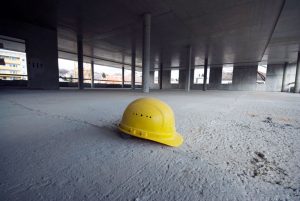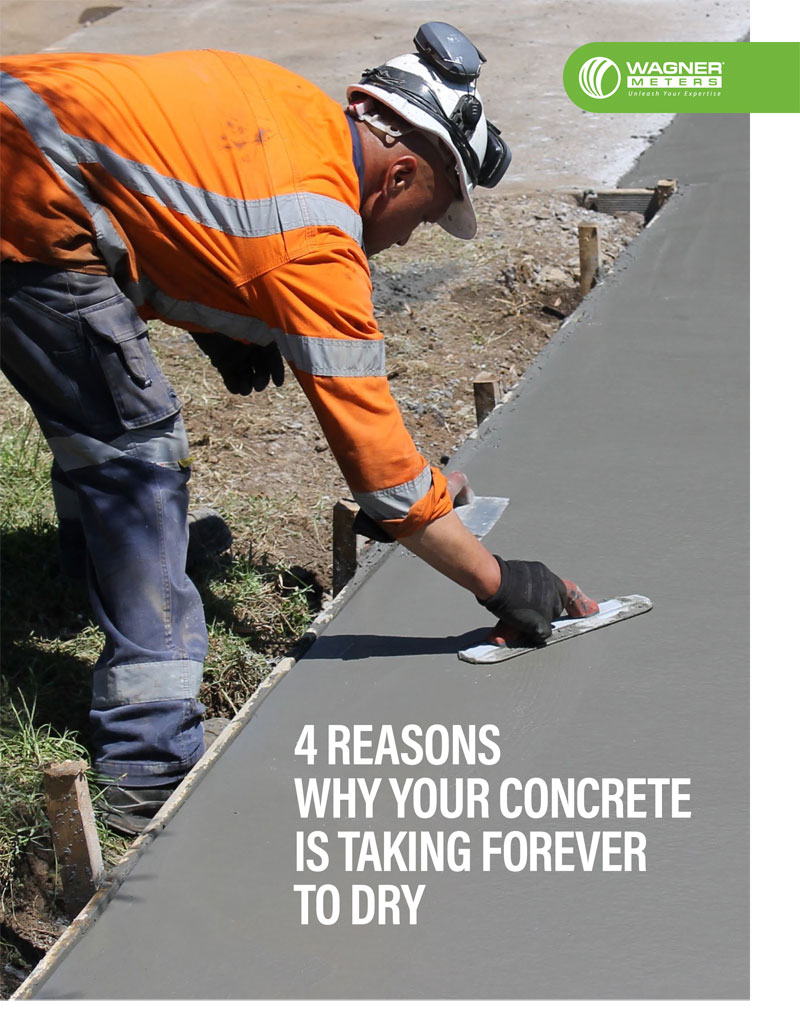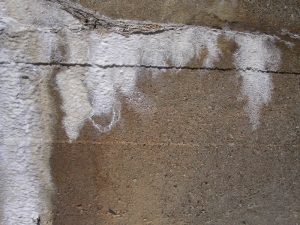The Dangers of Concrete That Sweats!
It Opens Up Pandora’s MAD Box…
 Concrete can sweat! Are you aware that this has been well-documented? Can the problem of concrete condensation really open Pandora’s “MAD” box? What is Pandora’s “MAD” box and how do we prevent this from happening? A lot of unanswered questions…
Concrete can sweat! Are you aware that this has been well-documented? Can the problem of concrete condensation really open Pandora’s “MAD” box? What is Pandora’s “MAD” box and how do we prevent this from happening? A lot of unanswered questions…
What Causes Concrete to Sweat
Concrete sweating, also known as sweating slab syndrome (SSS), refers to condensation that develops on the surface of the concrete. It is directly related to the dew point. “If the surface of a floor slab is colder than the dew point temperature of the ambient air above the slab, moisture will condense on the surface of the slab. This condition, commonly called “sweating,” typically occurs when warm, moist air flows into a building that has relatively cool floors.”1
“A second type of dew point condensation can occur if the concrete has a high moisture content and the surface is strongly cooled. For example, a floor slab with a resilient floor covering and no vapor retarder below the slab can have relative humidity in the mid-to-upper 90% range. If the HVAC system is set to cool the interior of the building just a few degrees below the ambient floor temperature, condensation on a concrete slab can occur in the upper region of the concrete, just below the floor covering. The presence of liquid water then dissolves compounds in the concrete that can raise the pH and begin to attack the adhesive and floor covering.”2
From this expert source, it is clear to see that concrete sweating can become a major problem…but open Pandora’s “MAD” box? The phrase sounds ominous enough…should we look inside? What is “MAD”?
- M = Mold Growth
- A = Alkali Attack
- D = Dangerous Slick Conditions
Mold Growth
Mold is a predominant factor in airborne allergies and pulmonary problems.
Any condition that supports mold growth and its associated problems should be avoided at all cost. A sweaty slab left unchecked is a perfect environment for mold spores to begin multiplying.
The building industry continues to push towards methods that promote a tighter “building envelope” (a good thing). Within those guidelines, proper care must be taken to ensure that…
- Buildings have proper ventilation systems in place.* This is very important as most moisture conditions that exist in a building are created by the occupants. For example; showering, laundry, cooking, etc. are primary causes of moisture within a home.
- Vapor retarders (or barriers) are in place between native soil and below-grade concrete…according to ASTM standards and local building codes. This is critical to preventing sweating slab syndrome.*
- Insulation is placed in strategic areas, according to ASTM standards and local building codes. Insulation plays an important role in maintaining a proper thermal break between native soil and any type of concrete foundation…between the internally conditioned climate and the external atmosphere. Whether it is a slab-on-grade foundation or below-grade basement walls…proper insulation is a key factor in preventing concrete from sweating.*
Minimizing any chance for water to condense on concrete…minimizes the opportunity for mold growth to begin.

Free Download – 4 Reasons Why Your Concrete Is Taking Forever to Dry
Alkali Attack
The alkali-silica reaction (ASR), more commonly known as “concrete cancer”, is a swelling reaction that occurs over time in concrete between the highly alkaline cement paste and the reactive non-crystalline (amorphous) silica found in many common aggregates, given sufficient moisture. ASR can lead to serious cracking in concrete, resulting in critical structural problems that can even force the demolition of a particular structure.3
“A vapor barrier may not have been installed under the slab when the concrete was poured. This can allow moisture from the ground to penetrate up through the concrete, resulting in damp conditions. If there are cracks in the slab and the drainage is poor, it may even cause ground water to seep up through the cracks and puddle on the floor.”4
 “Liquid water diffusing upward through a concrete floor slab can carry alkalis in a high pH solution that can attack floor finishes.”5 Over a period of time, alkali attack can cause permanent damage to the concrete itself. This can result in costly repairs.
“Liquid water diffusing upward through a concrete floor slab can carry alkalis in a high pH solution that can attack floor finishes.”5 Over a period of time, alkali attack can cause permanent damage to the concrete itself. This can result in costly repairs.
Dangerous Slick Conditions
Moisture that accumulates on any smooth surface can be an undeniable slipping hazard. Moisture that accumulates on sealed concrete creates an even more dangerously slick surface…while the damp environment that is so prevalent with the growth of mold can predispose concrete surfaces to slick, dangerous conditions. More evidence of the dangers of sweating concrete.
For concrete professionals…best practices dictate that careful planning prior to beginning your concrete project, and incorporating preventative measures to avoid any future moisture challenges provide the best solutions.
For consumers…if you suspect that you have a concrete moisture problem, retain a qualified concrete consultant to determine if you have a moisture problem and provide you with solutions to correct the problem.
Concrete can sweat…but don’t let it make you “MAD”.
*Always check with local building authorities as well as ASTM standards, to verify current codes and best practices.
2 Kanare, H.M., “Sources of Moisture”, Concrete Floors and Moisture, page 15.
3 “Alkali–silica reaction in concrete.” Understanding Cement. Archived from the original on 10 August 2007. Retrieved 2007-08-11.
4 https://www.todayshomeowner.com/how-to-deal-with-condensation-on-a-garage-floor/
5 Kanare, H.M., “Sources of Moisture”, Concrete Floors and Moisture, page 20.
Wagner Meters is a family-owned American business that aims to provide solutions in moisture measurement technology that will enhance the quality and value of each customer’s project. With an almost 60-year legacy of innovation, Wagner continues to be a resource for both individual craftsmen and high-performance commercial endeavors.
Related Posts via Taxonomies
Last updated on June 8th, 2021




I have water on a cement floor that is most likely coming up from the soil because of no vapor retardant under the concrete. Does the floor then need to be torn up to place this retardant and then re-laid? Please advise.
Thanks,
Carol
Carol:
Thanks for the question. Depending on what you are intending to do with the space, you can usually have a liquid form of the vapor barrier applied topically so the moisture transfer is minimal and a finished floor product can be installed. Tearing out a slab and starting over is only in the very worst situations. Good luck.
Hello,
We recently purchased a cottage (built 2005) The basement was unfinished just studs insulation and vapour barrier. We have closed in corner with walls for the water/pump/hot water tank etc. Recently added a stairwell because floors were not connected.
The concrete gets dark and damp in numerous areas and sweats. The back wall where the foundation is against the ground is the worst area. We are on a slope and front of basement faces lake with patio doors.
Would like to know what exactly is going on. Wondering if a vapor barrier was installed? The build of the cottage (so I have learned) was unsupervised. So I wonder about vapor barrier?
Would like to put in floor. What do you suggest.
We have purchased a air exchanger ( not installed).
What do you think about whole home dehumidifiers? What do you think about Dricore or similar products for subfloor?
Trying to figure out problem and what to do next!!
Thank you.
Jane Barker
Jane:
Thanks for the questions. You could have a geotechnical engineer come in and do a core sample to verify if there is a vapor retarder or not under the slab. It’s hard to know about the dehumidifier because I am not sure what the conditions in the air space are like. Besides verifying a retarder, I would also check to see what the dew point temperature of the environment is. This can be done by using a thermo-hygrometer to measure the relative humidity and temperature in the air and then plugging those numbers into something like this Dew Point Calculator (https://www.calculator.net/dew-point-calculator.html). This is the temperature, based on the current conditions, where condensation will form on a surface. Next, use an infrared thermometer to measure the temperature of the concrete surface. If that number is within about 5 degrees of the calculation, this may be the issue. Good luck.
Hello, Thanks for taking questions. I would really love to hear how you would recommend mitigating my issue. We bought a 1908 Craftsman house in a rather wet little town where the water table is famously high. Many residents in town have water issues in their home, even in some new homes if engineering wasn’t very carefully considered. We got a structural engineer to look at the leaky basement. He said to put in French drains. We did–not only along one foundation wall that we had rebuilt at the same time but also through the middle, following the plumbing line and then up to the front of the house where there is a bathroom that we (to code) put in at the same time. Then we painted the flooring and walls with Dry-Lock waterproofing paint as the engineer suggested. We put the vinyl floors in with the plastic barrier underneath it in August. Well, when we tore up the section two days ago–to make sure that we had gotten all the water from a small chimney leak (which it looked like we did), we noticed that the whole concrete floor that had plastic over top of it had been actively sweating. There are parts of the basement that we left unfinished due to our own time restraints. Those have never had any sweating or water surfacing from it. What does this mean? Does this mean that there is nothing that we can put on top of the very old concrete floors? One note: the concrete that we put in over top the new plumbing had no sweating or mildew/mold–but everything else did. Please help me know what kind of finishing I could put on it. I assume that we can’t put anything on it that won’t let it breathe. But I am also afraid to put carpet over it for the same reason–I don’t want it to mildew. We do have a laser HVAC system in that is supposed to kill any mold spores. And, the WINIX filter that we put on in the room went back to blue after about an hour of the flooring pulled up (and was blue before we pulled it up–with the vinyl planking on it). Thanks for any advice. Mainly I wonder if we can safely do an epoxy finish or if that would do the same thing and make for sweating again.
Cherise:
Thanks for the questions. First, I’m not convinced that the concrete is “sweating” because if it were, the entire area would exhibit these symptoms. More than likely what you are experiencing is moisture vapor moving up through the concrete, from the soil, because there is no vapor retarder below the slab. Waterproofing is great, done correctly, for waterproofing, but you are dealing with vapor. I would talk with the epoxy finish manufacturer and see what they offer with regards to a moisture mitigation solution that is applied prior to the final finish. Good luck.
Hi! I’m looking at buying a house built around the 1950’s. The current owner explained there’s no carpet throughout because the concrete floor sweats. My question is, should I run from buying this house?
Thank you in advance!
Beverly Rachel
bevrachel@gmail.com
I have one question. We are constructing 3B+G+21 building and we are currently on the construction of 5th floor. What I am seeing is located under the 2nd floor slab. Which is like sweating under and has a darker black color with a different odour. I have recognized that there hair-cracks. What can be the cause and the solution? Thankyou
Naod:
Thanks for the question. If it’s sweating on the bottom side I would rule out condensation by taking the bottom temperature and compare it to the dew point calculation based on the temperature and humidity of the environment on the first floor. This may be the problem and it may solve itself when the HVAC units are turned on. Good luck.
Jason I have an old machine shed that is always sweating, the building is probably 80+ years old, so of course I didn’t pour the floor, my other outbuildings don’t have any issues, so I’m kinda surprised my shop is Thanks,Gary
Hello Jason,
What would be a better sealer please? There are so many to choose from! Thanks!
Isabelle:
Thanks for the question. Unfortunately, I can’t recommend a specific brand of product, but I can tell you that the epoxy sealers seem to be the best. Good luck.
Jason – we have LVT plank flooring over the basement slab. After about a year, minerals and water started creeping up between the plank seams. The planks were pulled up and the slab was sealed with a concrete sealant. It worked for about 6 months and now more mineral deposits are showing up in the seams. What would you suggest to use to seal that portion of concrete under the vinyl planks? Its a slab that is 18 years old and had no problems until we finished the basement 2 years ago and put flooring over the slab. Thank you.
Tyler:
Thanks for the question. You will probably need to either go to a better “sealer”, one that is good to 100% relative humidity in the concrete, is warranted in a basement setting, works on a slab with no vapor retarder (due to age, odds are pretty high if yours had one, it may not still be intact), and works up to a 14 pH. Most of the mineral deposits are salts moving to the surface of the concrete. The other option is to go to a more breathable flooring product. I hope this helps.
Jason
Is there a solution to a slab that has been subject to an “Alkali Attack”
Cliff:
Thanks for the question. I would need to better understand the specific problem you are outlining. How is it presenting?